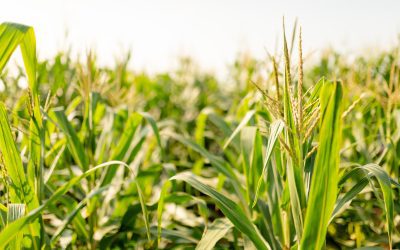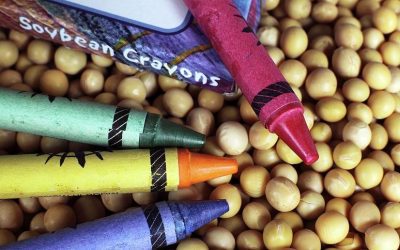Nine years ago, the United States and Colombia signed the U.S.-Colombia Trade Promotion Agreement, which immediately removed tariffs on about 80 percent of agricultural and other U.S. exports and scheduled removal of others over 10 years.
Not long after, the Indiana Soybean Alliance (ISA) identified the South American nation as a “country of interest” to the state’s farmers, both because it is relatively easy to reach for travel and shipping and for the rich potential of sales. ISA Senior Director of Grain Production and Utilization, Ed Ebert, said in 2016 about 20 farmer board members visited Colombia, then decided they needed to grow the relationships they’d formed with local end users and processors.
Using state checkoff funds, ISA board member and farmer Mark Legan from Coatesville, Ind., noted ISA can target growth programs to specific markets like Colombia through national partners. One of these partnerships with the U.S. Soybean Export Council (USSEC) is exporting Indiana soybean oil. This also includes educating end users on the quality and sustainability of U.S. product versus oil originating from other countries.
He said Colombia is “an economy that’s opening up, and as people move to a higher level of income, the first thing they do is upgrade their diet” – usually focusing on putting more protein on the plate.
Protein is king
The American Soybean Assoc. World Initiative for Soy in Human Health (WISHH) is another national partner for ISA. Executive Director Liz Hare explained in developing nations, as people’s incomes increase and their standard of living rises, they begin demanding higher-protein food – including eggs and meat from livestock, poultry and aquaculture fed on soy meal.
WISHH’s impetus is to introduce U.S. soy into emerging markets as a reliable, sustainable protein source both for human consumption and livestock use, the latter of which makes up 70 percent or more of local food production.
“We know in a place like Ghana (for instance), local production of soybeans does not meet current demand that exists now, today,” Hare said, explaining much of the growth potential in this and similar markets is in animal feed.
One of WISHH’s chief efforts is persuading farmers abroad to replace home-mixed feed and food waste given to animals with more formulated feed containing soy. She said local representatives do feeding trials and demonstrate the practices and results at field days to show producers the difference it makes in animal development. At the same time, local millers/processors can meet farmers, learn their needs and tout the benefits of higher-quality feedstuffs made with U.S. soybeans.
“The farmers see the difference in those field days,” Hare said, “(and) that causes them to seek out the formulated feeds.”
An ocean apart, Ghana and Colombia are just two countries with significant potential to increase their purchases of U.S. soy. Mac Marshall, vice president, Market Intelligence for United Soybean Board (USB) and USSEC, noted Southeast Asian economies also growing rapidly include Indonesia, which is one of the United States’ top 10 largest-volume soybean export market. Vietnam – which ISA farmer-members visited in 2018 – has increased its U.S. soy imports more than fivefold in the past decade, and Thailand and Philippines have each tripled their purchases in that time.
And Bangladesh – the world’s eighth most-populous country – has really taken off as an emerging market, he said. Ten years ago, the U.S. didn’t export whole soybeans there and in 2020, it shipped 1.3 million metric tons. Though he said this year the U.S. has seen some decline to that because of duty changes. Bangladesh’s soy meal demand is increasing.
‘Prime these markets’
In Colombia, Marshall said in 2011 the U.S. sold fewer than 50,000 metric tons of soybean meal, whereas that figure is now approaching 1.4 million. Neighboring Ecuador has increased its purchases four-fold in that same decade and, nearby, Honduras has doubled its imports. Much of that growth, he noted, has occurred during the past five years and is a testament to work done by checkoff-funded efforts to “prime these markets” and give the farmers and processors a taste of the quality U.S. soy offers the animal ag sector.
In Africa, U.S. Soy leadership has established two Soy Excellence Centers in Egypt and Nigeria over the past two years. Marshall said many countries in Sub-Saharan Africa are not importing soybeans or soy products because consumption isn’t high enough. However, by showing what soybean meal can do for their domestic poultry quality, he thinks the U.S. might persuade local operators to build a preference.
For example, through the work of international marketing programs and U.S. Soy, Egypt has scaled up its chicken production over the last 20 years, becoming a notable importer of both soybeans and soybean meal. The U.S. has quadrupled its whole bean exports there since 2010, with 4 million tons shipped in 2020. Need for aquaculture feed is growing too.
“You also see this changeover in their import behavior, from being meal importers to scaling up their processing for whole-bean capacity,” Marshall noted, explaining processing infrastructure helps create permanence of continuous demand for U.S. beans. Once more countries in Sub-Saharan Africa build up “maturation factors” and increase need for soy, he said the hope is they will look to the U.S. first.
The importance of making U.S. soy attractive to emerging markets and even seeking expanded sales with established customers was highlighted by the drop in exports to China in 2018 and 2019. That trade war emphasized the need for increased market diversification, he said; it also helped spur the Dare to Compare campaign USSEC launched last November.
This is an effort aimed at teaching livestock producers the nutritional benefits of soy in animal rations, and noting even if U.S. soy costs more than, say, Brazilian soybeans, the meal earns that difference in performance. Marketing soy is about proving buyers’ bang for their buck even if the U.S. is not always the least expensive supplier.
“It’s really about showing how we’re differentiated,” Marshall said, adding U.S. soy is uniquely high-quality, sustainable and reliable, since the United States has strong infrastructure to provide this product year-over-year.
Aiming for longevity
Another of WISHH’s key efforts is what Hare called a “market systems approach” – doing work along the value chain to make sure the components are set in place for future and sustained soy imports, to help ensure a target nation’s food security.
“Food security is really just access to affordable and available food,” she said, and WISHH’s goal is to create a bridge between “there’s an issue here” and “we want U.S. soy to be part of that solution … If these things improved just a little bit, if we took these things up just a few notches, so much could be done.”
In many places, she said human consumption of soy begins with school meals. That government will award contracts to supply the meals, which gives local businesses opportunity to fill them. From there, these suppliers expand to providing commercial grocery food. On the livestock feed side, poultry and eggs are a major market in a number of countries where soy can begin, then expand to aquaculture production.

A few years ago, Hare explained U.S. Soy checkoff redid its international marketing strategy, dividing countries into four categories: developing, emerging, expanding and mature. WISHH, established in 2000, works only in developing and emerging markets that don’t already import U.S. soy, or very little – once a specific industry’s soy purchases and use reach the “expanding” or “mature” point, USSEC takes over the programs.
Just one example is CAST (Commercialization of Aquaculture for Sustainable Trade) in Cambodia, which is a five-year, $17 million project to improve the country’s farmed seafood industry. Part of building a successful infrastructure for this industry to continue being able to purchase U.S. soy has been encouraging the creation of a national aquaculturalist association whose membership includes farmers, feed millers, other businesses and government representatives.
In Cambodia, Hare said the government recognizes aquaculture as a key in the national economy’s recovery from COVID-19. The association is hoping to allow farmers and millers to advocate for their needs into the future, long after CAST ends, and to pay dividends to U.S. growers in the form of continued soy imports. WISHH is also assisting with introducing soy for hog feeding trials in the country, as well as in direct human food use.
In Sri Lanka and Central American countries, WISHH is also working to promote soy for direct human consumption. In Central America, she said there is significant growth potential in demand for high-protein beverages and “grab-and-go” soy food products similar to those sold in the U.S.
She explained WISHH works closely with each nation’s farmers and agribusinesses to gear technical training toward what they really need to help grow soy-fed markets. When COVID-19 struck a year ago, partner companies in Africa reported they still wanted training, but in-person help wasn’t safe. WISHH shifted to virtual online training; in fact, going virtual even allowed more experienced partners in one country to help train those in a newer market.
Promoting engagement
Going virtual has helped ISA adjust marketing in the last year too. Unable to host foreign buyers in person, Ed Ebert said Indiana farmers have been able to provide them an up-close look in their fields during planting, harvesting, and mid-season tours via Zoom and other streaming platforms
He said ISA is a significant supporter of U.S. Soy through membership and targeted programs it sponsors to focus on areas ISA directors have identified as having growth potential for soybeans.
Such engagement, Ebert added, is about getting farmers involved directly in overseas sales. It lets them know they’re not “just sending a bunch of money someplace,” but allows them to take ownership of helping develop U.S. and Indiana trade relations: “All of our work is complementary to creating additional demand and moving the pile in market development.”
In total use of the soybean, Marshall said worldwide the primary driver is still in meal for animal feed and oil for human consumption. But there are opportunities for expanded usage, such as the growing market for biodiesel and bioproducts such as foam and rubber. Some of the more novel products are discovered through national and state checkoff efforts – in Indiana, one of these best-known sponsorships is the ISA/Purdue University Student Soybean Innovation Competition, which has been inventing new soybean uses for nearly 30 years.
“These are smaller opportunities in terms of volume that really help underscore how versatile the soybean is” for future marketing, Marshall explained.
That cooperation between national and state soy checkoff groups is one of the most critical factors to success for grower exports, he added. As supply chains globally become more transparent to consumers, buyers want a better understanding of where the raw product comes from and how it’s grown – and state checkoffs like ISA are key actors in doing just that.
In fact, telling the U.S. farm story in foreign markets is “one of the best uses” ISA’s Legan believes he has seen of state checkoff dollars.



